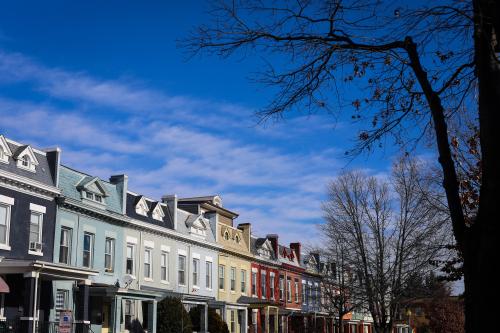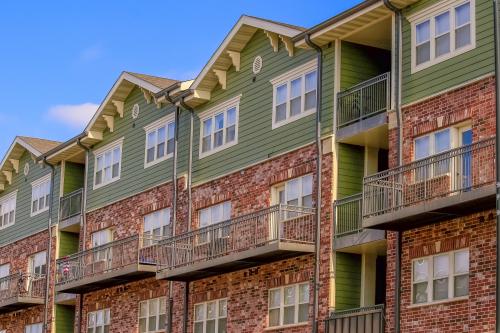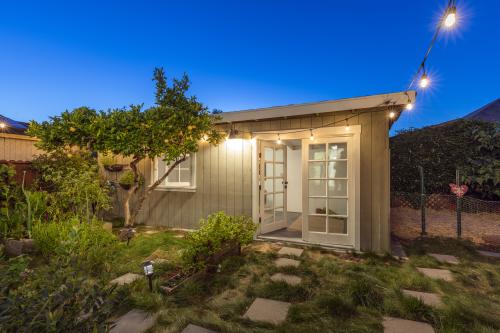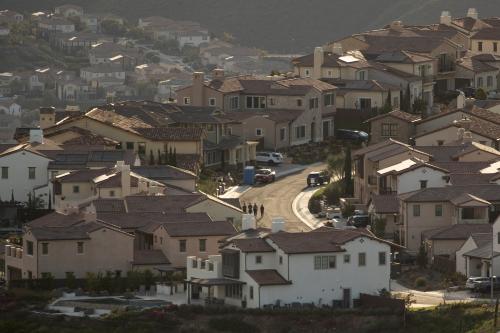Contents
- Virginia does not have a statewide housing shortage, but there are local warning signs
- Low-income Virginians across the state struggle to pay for housing
- Housing quality is a concern in both cities and rural communities
- Climate change is already harming Virginia’s homes and communities—and will get worse
- What Virginia’s next governor can do to help
Communities across Virginia are facing a variety of housing-related stresses. Over the past year, housing prices have risen more than 10% in the state’s largest metropolitan areas, putting pressure on first-time homebuyers. During the height of the COVID-19 pandemic, more than half of renter households experienced income losses, and roughly 20% fell behind on their rent. Even before the COVID-19 pandemic, Richmond had one of the highest eviction rates in the country, especially in historically Black neighborhoods. As Virginia’s voters prepare to choose a new governor this year, they should evaluate the candidates’ plans to address housing challenges.
Well-functioning housing markets are critical to the commonwealth’s economic success. High housing costs make it difficult for employers to attract and retain good workers—especially as expanded telework and hybrid work become more common. Communities that can offer high-quality amenities—such as public schools, parks, restaurants, and cultural attractions—at reasonable prices will be most attractive to workers who can choose their location. Access to stable, decent-quality housing in safe, healthy communities allows people to engage productively in school, work, and other social and economic activities.
While housing has typically been left up to local governments, four key challenges would benefit from state-level attention: monitoring regional housing supply, providing income support for poor households, investments to upgrade housing quality, and climate resilience efforts.
Virginia does not have a statewide housing shortage, but there are local warning signs
Over the past 10 years, Virginia’s housing market has performed well along a key dimension: Housing supply has grown more in the places people most want to live. Housing prices are a useful indicator of underlying demand, because people are willing to pay more for homes located near well-paying jobs and in communities with good public schools, parks, and other amenities. Between 2010 and 2019, housing supply grew more in the Virginia counties and independent cities that had relatively high housing values in 2010—an indicator of healthy statewide housing markets.

But there are some localized warning signs of tight supply, especially in the Washington, D.C. metro area. Figure 2 shows the relationship between initial housing values and housing growth for each of the three largest metro areas in Virginia. Richmond and Virginia Beach show similar patterns to the state overall: Both have strong positive correlations between housing values in 2010 and growth in housing supply over the subsequent decade.
The Washington, D.C. metro area—the largest region in the state—shows a markedly different pattern. The correlation between initial housing prices and supply growth there is much smaller (flatter slope) than in Richmond or Virginia Beach, reflecting wide variation in growth rates among communities with similar housing values. While some expensive communities, such as Loudoun County and Falls Church, saw housing growth rates over 20%, Fairfax County and Alexandria saw 6% and 8% housing growth, respectively—well below the region’s average. Fairfax has the largest population in the state (over 1 million residents) and is home to major job centers such as Tysons Corner; any housing shortfalls in the county will have repercussions for the entire metro area.

Outside of the largest metro areas, there are also signs that housing supply may be lagging demand in some regional job centers. Housing affordability and availability have become increasingly contentious issues in both Blacksburg and Charlottesville, where the commonwealth’s flagship universities have led to regional job growth in related industries such as medicine and technology. Some of these jobs pay high wages, allowing workers to afford housing near their workplace. But workers in lower-paid support jobs—such as clerical work, food service, and housekeeping—often must seek cheaper housing in neighboring counties, resulting in longer commutes and higher traffic volumes.
How much housing gets built in what locations is not just a function of market forces; local governments regulate housing development through policies such as zoning and building codes. Excessively strict zoning, such as large minimum lot sizes, prohibitions on apartments, and complex development processes can reduce the supply of new housing and increase housing costs. In states such as California and Massachusetts, local zoning regulations now add up to a substantial drag on the overall statewide housing supply—a cautionary tale that Virginia should avoid.
Low-income Virginians across the state struggle to pay for housing
Even in places adding enough new housing to keep up with job growth, lower-income households have difficulty paying for market rate housing. The incomes of many lower-paid workers have not kept pace with increases in rent.
The U.S. Department of Housing and Urban Development recommends that households spend no more than 30% of their income on housing. Among Virginia’s poorest households, both renters and homeowners spend around 60% of their income on housing costs (Figure 3). High housing cost burdens lead many households to cut back on food, health care, transportation, and other necessities, while impeding their ability to save for a rainy day. The gap between income and housing costs exists in all parts of Virginia—urban, suburban, and rural—similar to long-standing national trends.

Housing quality is a concern in both cities and rural communities
While housing affordability generally receives more attention, a related concern is the prevalence of poor-quality housing. In Virginia, older homes are especially common among large cities; for example, more than 30% of Richmond’s housing was built before 1940.
Some older homes have been recently renovated and are valued for their historic architecture (Old Town Alexandria and the Fan neighborhood in Richmond, for instance). In general, though, older homes are prone to health hazards such as unabated lead paint and asbestos, require more energy to heat and cool, and have higher maintenance costs for their owners.
Virginia’s rural communities, meanwhile, have high proportions of vacant homes. Vacant housing can be a source of blight for the surrounding community, creating health and safety hazards for neighbors and leading to higher crime rates. Suburban communities, on the other hand, have both new housing and lower vacancy rates than either cities or rural areas.

Climate change is already harming Virginia’s homes and communities—and will get worse
The physical, economic, and human costs of climate change are becoming increasingly tangible in Virginia, and around the country. Intense storms and sea-level rise are causing wind and water damage to homes and businesses. Extreme heat is creating health and safety threats, especially for older adults, people experiencing homelessness, and those whose homes lack air conditioning.
The harms of climate change are disproportionately borne by low-income, Black, Latino or Hispanic, and Native American communities. Richmond’s previously redlined majority-Black neighborhoods suffer from higher heat exposure. The Virginia Beach-Norfolk-Newport News metro area—home to nearly two million people—already experiences frequent inundation because of sea-level rise. Even inland communities like the Roanoke Valley are seeing more frequent flooding from intense storms. The energy consumed to heat and cool homes is a major contributor to climate change, as are transportation costs incurred by ever-lengthening commutes throughout the commonwealth.
What Virginia’s next governor can do to help
Strategic housing policy choices by Virginia’s next governor can strengthen the state’s economy, reduce financial stress on households, and improve climate resilience. State intervention would be most useful in five areas:
1) Encourage high-opportunity communities throughout the state to expand the supply of moderately priced housing. Providing policy guidance, technical support, and financial incentives would support local governments in modernizing their land use regulations and related development policies. Allowing enough housing at a range of price points is necessary to support state and regional economic growth, while reducing financial stress on moderate- and middle-income households.
2) Expand funds for housing vouchers to low-income renters and invest in acquiring or developing subsidized apartments. Support from the state’s congressional delegation would be useful to increase the availability of federal housing vouchers.
3) Invest in building maintenance and upgrades for older homes throughout the commonwealth. Expanded access to low-interest loans or grants for energy-efficient upgrades would improve housing quality for both homeowners and renters, while reducing household carbon footprints.
4) Better integrate housing, transportation, and land use to improve climate resilience. Virginia and the federal government are currently negotiating a once-in-a-generation investment to expand passenger rail service. This plan offers the opportunity to strengthen connections between Virginia’s communities and boost economic growth. But delivering the maximum economic and environmental return on this investment requires coordinating transportation, housing, and land use in proximity to rail stations.
5) Enable better policies through better information. Collecting and disseminating regular information on housing market conditions and unmet needs would be beneficial to state and local governments, as well as housing advocates and the real estate industry.







